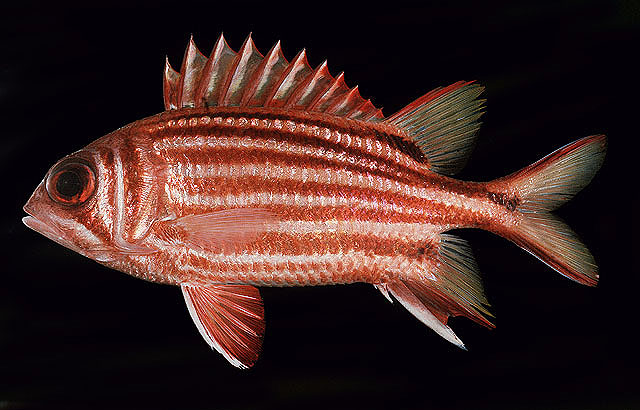| Holocentridae (Squirrelfishes, soldierfishes), subfamily: Holocentrinae |
| 32 cm TL (male/unsexed) |
|
reef-associated; marine; depth range 1 - 84 m |
| Indo-West Pacific: Red Sea to the western Pacific where it ranges from southern Japan to New Caledonia, Vanuatu and New South Wales, Australia. Recently recorded from Tonga (Ref. 53797). Not yet recorded from any oceanic island in the western Indian Ocean. Invaded eastern Mediterranean via the Suez Canal. |
|
Dorsal spines (total): 11-11; Dorsal soft rays (total): 12-14; Anal spines: 4-4; Anal soft rays: 8-10. Body with subequal stripes of brownish red and silvery white; spinous dorsal dark red with a large, quadrangular, whitish blotch in middle of each membrane (except the first) forming a median band; dorsal membrane tips white, except posteriorly (Ref. 4201). Five oblique scale rows on cheek; body depth 2.5-2.8 in SL; head length (HL) 2.65-2.85 in SL; short and blunt snout, its length 4.25-4.7 in HL; interorbital width 4.5 in HL; mouth terminal to slightly inferior, maxilla usually extending nearly to or a short distance beyond a vertical through center of eye, upper jaw length 2.5-2.75 in HL; premaxillary groove often ending above anterior edge of orbit; anterior end of nasal bone with a blunt spine; surface or medial edge of nasal bone spineless; nasal fossa usually without spinules on its edge; upper edge of 1st suborbital bone with a slightly retrorse lateral spine a short distance posterior to a vertical at front edge of eye, followed by a ridge of recumbent spinules; preopercular spine usually about 2/3 orbit diameter, 3.2-5.3 in HL; 3rd-5th dorsal spines subequal, longest in adults 1.9-2.3 in HL; 3rd anal spine 1.35-1.6 in HL (Ref. 27370). |
| Found in coastal reefs (Ref. 9710); silty reefs or wrecks in lagoons, bays, or harbors (Ref. 27370), may occur in aggregations; also found hidden in caves and cracks of rocks during the day (Ref. 12382, 48635), usually in areas subject to strong currents (Ref. 48635). Intertidal observations were also reported (Ref. 49162). Feed mainly on benthic crabs and shrimps (Ref. 2334), also preys on small fishes (Ref. 12382). Eggs and larvae are pelagic (Ref. 6746). Spine of preopercle venomous (Ref. 2334). Solitary or in groups (Ref 90102). |
|
Least Concern (LC); Date assessed: 04 March 2015 Ref. (130435)
|
| venomous |
|
Lessepsian migrant. Distributed along the northern Levantine coasts and the southern Aegean Sea (Ref. 94612). Also Ref. 3397, 50162. |
Source and more info: www.fishbase.org. For personal, classroom, and other internal use only. Not for publication.

